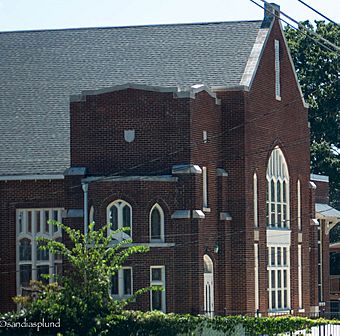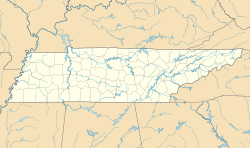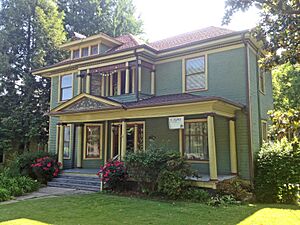St. Elmo Historic District (Chattanooga, Tennessee) facts for kids
Quick facts for kids |
|
|
St. Elmo Historic District
|
|

St. Elmo United Methodist Church
|
|
| Location | Chattanooga, Tennessee |
|---|---|
| Built | 1885 |
| Architect | Various |
| Architectural style | Victorian and Victorian bungalow |
| NRHP reference No. | 82003976 |
| Added to NRHP | April 4, 1992 |
The St. Elmo Historic District, often called St. Elmo, is a cool neighborhood in Chattanooga, Tennessee. It's located at the very southern tip of Hamilton County, nestled in the valley of Lookout Mountain. This area is special because it sits where two old Native American trails once met.
Long ago, people lived here. First, there were hunters and gatherers during the Woodland period. Later, farming communities like the Mississippians, including the Yuchi and Muscogee tribes, lived here. For a short time between 1776 and 1786, the Cherokee tribe had a community here called Lookout Town. St. Elmo officially became part of Chattanooga in September 1929.
Hundreds of buildings in St. Elmo were added to the National Register of Historic Places in 1982. This means they are important historical sites. In 1996, St. Elmo was named a Local Historic District. Many old buildings from the late 1800s and early 1900s have been kept safe and sound. People who live in St. Elmo are called 'Elmoians'.
Contents
Early Settlers of St. Elmo
In 1776, a Cherokee chief named Dragging Canoe and many warriors moved to Chickamauga Creek. They disagreed with an agreement between other Cherokees and American land buyers. They were known as the Chickamaugas. They later moved further down the Tennessee River and built "Five Lower Towns." Between 1777 and 1782, these Chickamaugas also had a town called Tsatanugi (or Chatanuga) near Chattanooga Creek.
A young Scottish immigrant named Daniel Ross came to the area in 1785. He worked at a trading post. Ross married the daughter of the area's first businessman, John McDonald. They built a house in what would become St. Elmo. Their youngest son, John Ross, became an important leader of the Cherokee Nation. He believed in peaceful protest against the government's plan to move Native Americans, which sadly led to the Trail of Tears in 1838.
How St. Elmo Got Its Name
Before 1838, the Tennessee River was the border between Hamilton County and the Cherokee lands. In 1839, the village of Chattanooga was created. In 1840, the state of Tennessee started selling the land that used to belong to the Cherokees.
James Whiteside bought a lot of land, including most of the northern part of Lookout Mountain. To attract visitors, Whiteside built a toll road up the mountain. He also built a three-story hotel for tourists, which opened in 1855.
One of the visitors was a young writer named Augusta Jane Evans. She became friends with Whiteside's daughter. Evans once said that the view of Chattanooga from Lookout Mountain reminded her of Naples, Italy from St. Elmo Castle.
After the American Civil War, Evans needed money. She published a novel called St. Elmo in 1866. It was a huge success, selling over a million copies in just four months! The story was set in the area. The neighborhood then took its name from this very popular book. Only Uncle Tom's Cabin by Harriet Beecher Stowe sold more copies in the 1800s.
Growth and Connections
In 1878, a yellow fever sickness spread in Chattanooga. Many people, almost 12,000, left the city. A lot of them went to Lookout Mountain. Back then, getting up the mountain was a long, four-hour trip on an old toll road. People complained about the high cost. So, in 1879, the St. Elmo Turnpike was built. It was easier to climb and cost less. This road was later paved and renamed the Adolph S. Ochs Highway in the late 1920s.
Until the 1880s, the area at the base of Lookout Mountain was mostly woods. St. Elmo really started to grow as a place to live around 1890. This was when the Chickamauga and Chattanooga National Military Park was created. Also, in 1893, an electric trolley line was extended from Chattanooga to St. Elmo, making it easier for people to travel.
Connecting St. Elmo to Chattanooga
The trolley wasn't the only new way to travel. In 1887, a special train called Incline #1 started taking cars from St. Elmo up to the cliffs of Lookout Mountain. Soon after, another line was opened for regular railroad cars. Then, in 1895, Incline #2 (now known as the Incline Railway) began taking passengers up the steepest part of the mountain. Its amazing views were very popular! By 1900, this railway was so successful that it caused all its competitors to close. Today, the "America's Most Amazing Mile" is still known as the world's steepest passenger railway.
In 1905, St. Elmo became an official town. A town group was formed to get money for a school. Money was raised, and a new brick school building was finished in late 1906. This new school replaced St. Elmo's first school, which opened in 1891.
It wasn't until 1926 that a direct road was built between St. Elmo and Chattanooga. The city wanted a main road to St. Elmo and Lookout Mountain. But Broad Street ended at a railroad station owned by the State of Georgia. For years, talks to open a path for a road had failed.
One night, on May 6, Chattanooga Commissioner Ed Bass decided to take action. He and a team of city workers used bulldozers to clear enough buildings to make a path for cars. The city got its road, and eventually, Georgia sold the rest of its land in the area.
- St. Elmo Historic District on LocalWiki




